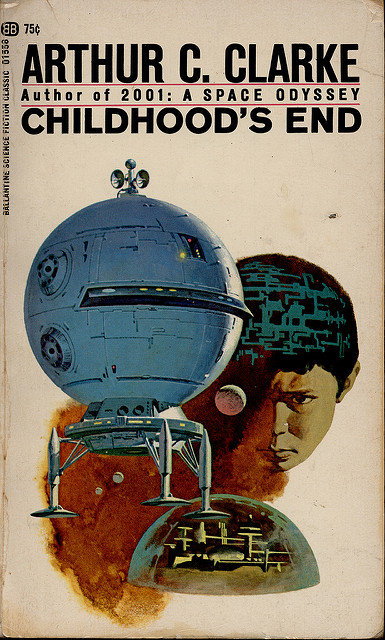
The novel “Childhood’s End” (cover image ©Brendan Riley) by Arthur C. Clarke was published for the first time in 1953. The first part was published in 1946 with the title “Guardian Angel”.
After a series of alien spaceships have appeared over the major cities of the Earth, everything has changed. The aliens have established indirect contact with humans, saying they want to prevent the extinction of humanity. They haven’t invaded Earth, however, they prove to be so more advanced than the humans tha they can easily impose peace in the world.
The UN Secretary General Rikki Stormgren regularly meets Supervisor Karellen, the leader of the Overlords’ expedition but never sees him in person, only with a wall between them. The Overlords are never seen by humans and even the term “Overlords” is a human invention. After some time, Karellen tells Stormgren that after 50 years the Overlords will reveal their appearance to humans.
In 1946, Arthur C. Clarke wrote the short story “Guardian Angel”. Initially, it was rejected by several magazines and only in 1950 was published in a modified version by James Blish in the magazine “Famous Fantastic Mysteries”. The original version was published a few months later in the magazine “New Worlds”.
At the beginning of the ’50s, Arthur C. Clarke started focusing on his writing activity and reprised “Guardian Angel” making it the first part of a novel which became “Childhood’s End”. He wrote two distinct ends and it took quite some time before choosing one. Eventually, the novel was published in 1953.
Often Arthur C. Clarke was accused of being an author too focused on developing plots based on scientific and technological elements. The rigor of his stories made him one of the masters of hard science fiction but he also got the reputation of being rather limited in the development of his characters, giving little to emotions and feelings.
“Childhood’s End” is in some ways an exception in Arthur C. Clarke’s production. It’s in fact a story in which he explains very little of the Overlords’ science and technologies and focuses instead on humanity’s future through the characters’ stories.
The plot of “Childhood’s End” is divided in three parts spanning a couple of centuries with a number of leaps forward in time. The beginning seems that of a classic tale of alien invasion, so much so that in the following decades many television and cinema productions started with alien spaceships arriving on the Earth’s cities. The reality in this novel is quite different because the only thing that the Overlords impose is peace.
It’s sad to have the prospect that without an outside intervention by a much more advanced alien species humanity can destroy itself but this is only a minor element in “Childhood’s End”. The real base subject of the novel is the ultimate destiny of humanity, which is slowly discovered in the course of the story.
In the first part of the novel, the Overlords remain hidden from humans. Especially in the period after their arrival, humans are wondering the reasons of the aliens’s reluctance. Only when Overlords finally reveal their appearance the mystery gets solved.
Because of the long time covered by the story, the human characters are different in the various parts. The only one who’s present throughout the novel is Supervisor Karellen because Overlords have a lifespan much longer than humans. Arthur C. Clarke used in particular some humans as witnesses of the changes on Earth allowing us to get to know their wishes and their motivations.
The first part of the novel is in many ways the story of the unlikely friendship between the UN Secretary General Stormgren and Supervisor Karellen. Despite the strict separation between them and the limits in what Karellen reveals, between the two of them there’s a relationship that goes far beyond their roles in world politics. Through the story of their relationship, Arthur C. Clarke tells the story of Earth in the years after the arrival of the Overlords and the changes that follow.
In the following parts, Arthur C. Clarke tels the changes in humanity over the next few centuries. The eschatological theme becomes more and more explicit with the progressive revelation of the future of humanity. At the same time, the secrets of the Overlords and their role in the destiny of humanity are revealed.
Arthur C. Clarke uses the stories of individuals to reach a transcendent cosmic dimension. The fate of humanity described in “Childhood’s End” is very different from that to which I aspire but personally I find the vision of this novel very evocative.
In this novel, the sense-of-wonder is the growing scale of the story, which starts from the mystery around the Overlords to get broader and broader with revelations and twists. Over the years, Arthur C. Clarke has repeatedly addressed the issues of “Childhood’s End” but in my opinion in this novel he was able to develop them to the fullest.
It’s for these reasons that I think that “Childhood’s End” is the best novel by Arthur C. Clarke even if he wrote other great ones that received various awards. Over the years there have been several projects of television or cinema adaptations but until recently none reached production stage.
At one point even Stanley Kubrick planned to make a movie out of “Childhood’s End” but at that time it had already been optioned for a project that never went through. Eventually Kubrick worked with Clarke to create “2001: A Space Odyssey” we can’t complain.
After many years the American channel SyFy produced a mini-series broadcast at the end of 2015, however, the story was modified in various ways. As for the novel, I think it’s a classic and a must-have for anyone interested in science fiction.


Permalink